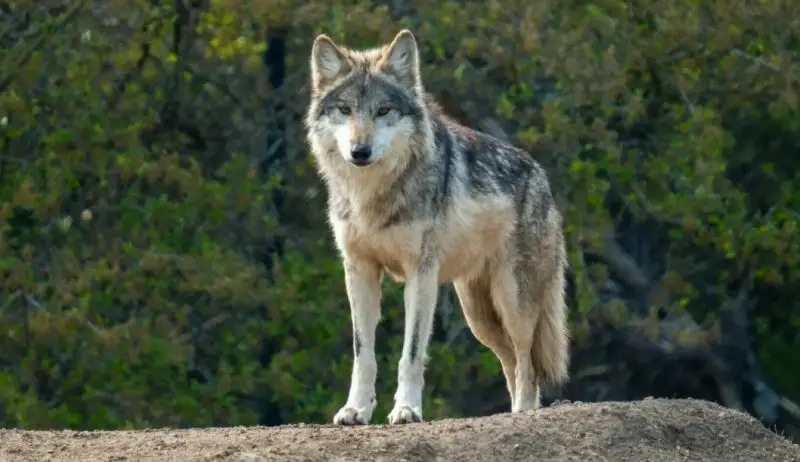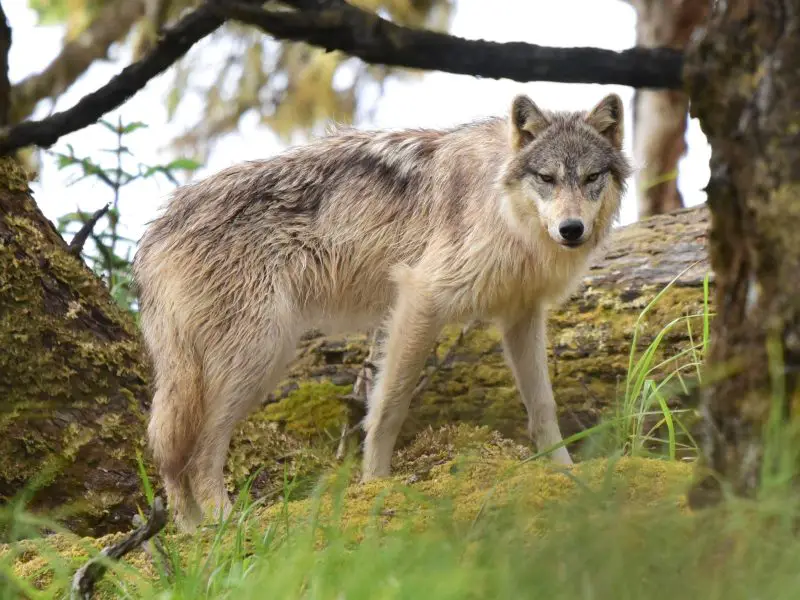Wolves in Arizona are a rare yet powerful symbol of the wild Southwest. These elusive predators once roamed much of the region but now survive only in select areas under strict protection. Their presence is a sign of ecological health, and efforts to conserve them reflect a growing appreciation for nature’s balance.
Today, there are two types of wolves in Arizona: the Mexican gray wolf and the occasional gray wolf. While one is part of an active recovery program, the other appears rarely and naturally from nearby states. Both types play vital roles in the landscape and spark interest among wildlife enthusiasts and conservationists.
In this guide, you’ll learn how to identify the two types of wolves in Arizona through physical features, behavior, and habitat. With detailed pictures and insights, we’ll explore where these wolves live, what threats they face, and how you can safely observe them in the wild.
Common Wolves Found in Arizona
Mexican Gray Wolf (Canis lupus baileyi)

The Mexican gray wolf, scientifically known as Canis lupus baileyi, is the smallest and most genetically distinct subspecies of the gray wolf. It typically measures around 4.5 to 5.5 feet in length from nose to tail and stands about 26 to 32 inches at the shoulder. Adults usually weigh between 50 and 80 pounds, with males being slightly larger than females. Their coat is a mix of buff, gray, black, and rust, providing effective camouflage in the scrublands and forests of the Southwest. This subspecies has a more slender build and narrower skull compared to other gray wolves, an adaptation to the warmer, drier environments of the American Southwest and northern Mexico.
Mexican gray wolves are social animals that live and hunt in family groups called packs, typically consisting of a mated pair and their offspring. They are territorial and communicate through howls, scent-marking, body postures, and facial expressions. Mating occurs in late winter, and after a gestation period of about 63 days, the female gives birth to a litter of 4 to 6 pups. These wolves are primarily crepuscular, being most active during dawn and dusk, and they rely on their keen senses of smell and hearing to navigate and locate prey in rugged terrain.
Their diet primarily consists of medium-sized to large mammals, such as elk, white-tailed deer, mule deer, and javelina. They may also eat smaller animals like rabbits, rodents, and birds when larger prey is scarce. Like all wolves, they are carnivorous and play a crucial role in maintaining ecosystem balance by regulating ungulate populations. Mexican gray wolves are endurance predators, meaning they rely on stamina rather than speed to exhaust and capture their prey, often hunting cooperatively in packs to bring down larger animals.
In Arizona, Mexican gray wolves are primarily found in the eastern part of the state, within the Apache-Sitgreaves National Forest. This area is part of the Blue Range Wolf Recovery Area (BRWRA), which spans eastern Arizona and western New Mexico. Their preferred habitats are mixed-conifer forests, woodlands, and scrublands that offer both cover and access to prey. Reintroduced into the wild starting in 1998, their population in Arizona is still carefully monitored and supported by conservation efforts. Despite continued challenges like habitat fragmentation and human-wildlife conflict, their numbers are slowly increasing under federal protection.
Gray Wolf (Canis lupus)

The gray wolf (Canis lupus), the largest wild member of the dog family, is a powerful and adaptable predator. Adult gray wolves typically range from 4.5 to 6.5 feet in length including the tail and stand about 26 to 34 inches tall at the shoulder. Weights vary by region, but individuals in the western United States can weigh between 70 and 120 pounds, with males being larger than females. Their thick, double-layered coat comes in various shades of gray, black, white, and brown, depending on region and genetics. They have a broad snout, long legs, and large paws equipped for endurance travel across rugged terrain.
Gray wolves are known for their complex social structures. They live in packs that function as family units, usually composed of an alpha male and female, their offspring, and sometimes unrelated individuals. Each pack has a defined territory and communicates through howls, body language, and scent markings. Gray wolves exhibit cooperative behavior in both hunting and pup-rearing. They are highly intelligent, capable of strategic hunting techniques, and can travel over 30 miles a day in search of food.
Their diet is diverse but primarily composed of large ungulates such as elk, deer, bison, and moose. In regions where large prey is less available, they may consume smaller mammals like beavers, hares, or even carrion. Wolves are apex predators, and their presence has measurable ecological impacts. For instance, their reintroduction in Yellowstone National Park helped control deer populations and encouraged vegetation regrowth, illustrating their role in trophic cascades. They typically hunt in coordinated groups to surround and bring down large prey efficiently.
While gray wolves were historically extirpated from Arizona, recent decades have seen rare instances of natural recolonization from northern populations. Sightings of wandering individuals, particularly from Colorado’s reintroduction efforts, have been documented in northern Arizona, but no established packs currently exist in the state. If any gray wolves are present in Arizona today, they are likely transients passing through forested or mountainous terrain near the Colorado Plateau. Their potential return raises both ecological interest and debate, particularly regarding coexistence with ranching and rural communities.
How to Identify Wolves in the Wild
Telling Wolves Apart from Hybrids and Domestic Dogs
Identifying a true wild wolf can be difficult, especially when compared to wolf-dog hybrids or large domestic breeds like the Alaskan Malamute or German Shepherd. Wolves tend to have leaner, longer limbs, larger feet, and broader heads. Their chests are narrower, and their tails are typically held straight down rather than curled. Hybrids may exhibit a mix of traits, such as inconsistent coat patterns, shorter legs, or unusual behavior around humans. Wolves are generally wary of people, while hybrids or domestic dogs may approach more readily or display less fear.
Observing from a Distance: Tracks, Howls, and Behavior
One of the most reliable ways to detect wolves in the wild is by studying tracks. Wolf tracks are typically 4 to 5 inches long and more elongated than those of domestic dogs. Their gait often shows a direct-register walking pattern, where the hind foot lands precisely in the front foot’s track. Wolf howls are another clue—they are long, low-pitched, and often rise and fall slowly. Compared to coyotes, wolf howls are deeper and carry farther. Behaviorally, wolves tend to be more elusive and travel in structured groups, often moving along ridgelines, forest roads, or animal trails in search of prey.
Safety Tips When Encountering Wolves in the Wild
While wolf attacks on humans are extremely rare, it’s important to maintain safety and respect for these wild animals. If you see a wolf, observe from a distance—do not approach or attempt to feed it. Make yourself look larger by standing tall, and speak firmly if the animal seems curious or lingers. Never run, as this could trigger a chase response. If you’re camping in wolf territory, store food properly and avoid leaving scraps around. Educating yourself about wolf behavior before hiking in wolf-inhabited areas ensures a safer and more respectful experience for both you and the wildlife.
Conservation Status and Challenges in Arizona
Legal Status of the Two Wolf Species
In Arizona, the Mexican gray wolf (Canis lupus baileyi) is listed as Endangered under the U.S. Endangered Species Act (ESA), granting it federal protection. This designation prohibits hunting or harming the species and mandates active recovery efforts. The gray wolf (Canis lupus), while not currently established in Arizona, also enjoys protection under the ESA in certain regions, though its status has fluctuated in recent years due to changing federal policies. Arizona adheres to federal guidance in managing any potential wolf presence.
Major Threats: Hunting, Habitat Loss, and Human Conflict
Mexican gray wolves continue to face significant threats in Arizona. Illegal shooting is a major concern, often stemming from mistaken identity or intentional killing by individuals who view wolves as a threat to livestock. Habitat fragmentation from development, logging, and road expansion also reduces viable territory and disrupts wolf movement. Additionally, conflicts with ranchers—due to occasional livestock predation—create tension between conservation goals and local livelihoods, despite compensation programs and preventive tools like fencing and livestock guardian animals.
Recovery Efforts: Federal, State, and Nonprofit Involvement
The recovery of wolves in Arizona has relied on cooperation between the U.S. Fish and Wildlife Service (USFWS), Arizona Game and Fish Department, and various conservation organizations such as the Defenders of Wildlife and Center for Biological Diversity. Since the first reintroduction in 1998, the Blue Range Wolf Recovery Area has become a central focus. Strategies include captive breeding, pup cross-fostering, radio-collaring for monitoring, and community outreach. Educational programs aim to shift public perception toward coexistence and highlight the ecological benefits of wolves, such as controlling overpopulated deer and elk.
Conclusion
Wolves are a vital part of Arizona’s natural heritage and ecosystems. The Mexican gray wolf, in particular, represents a unique and endangered lineage that once roamed widely across the Southwest. While the gray wolf is not currently established in the state, its occasional presence and potential for future return open important discussions about ecological restoration and human-wildlife coexistence. These apex predators help maintain healthy prey populations and contribute to balanced, biodiverse landscapes.
Protecting Arizona’s wolves requires ongoing support from both government and citizens. Sustainable coexistence involves practical measures such as non-lethal livestock protection, responsible land use, and science-based management. For local communities, it also means recognizing the role wolves play in regional ecology and culture.
Finally, observing wolves in the wild can be a rewarding and educational experience when done responsibly. Visitors and locals alike are encouraged to learn about wolf behavior, follow safe wildlife viewing practices, and support conservation initiatives. In doing so, they help ensure that Arizona remains a place where these magnificent animals can thrive alongside people.






